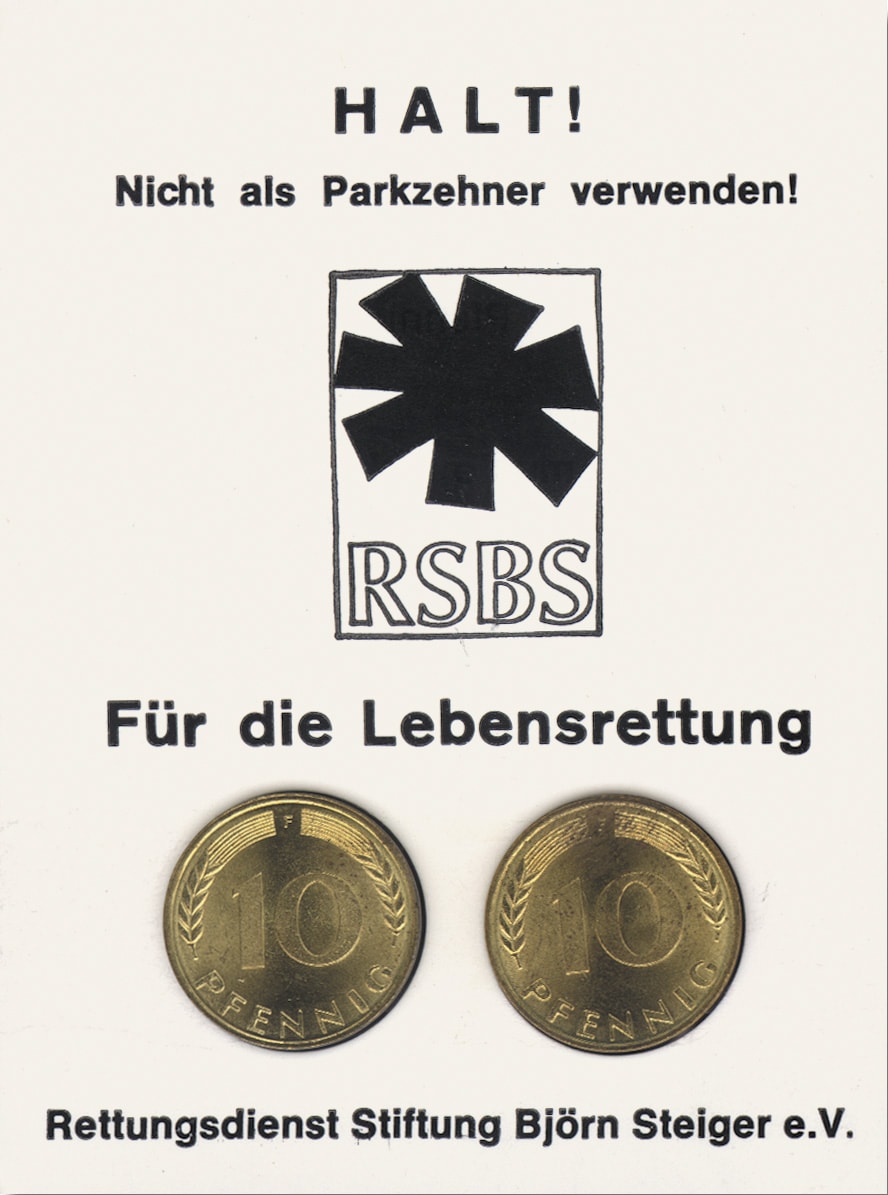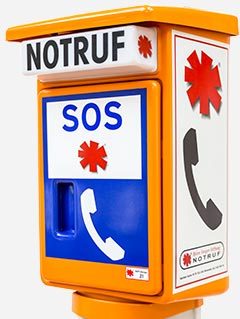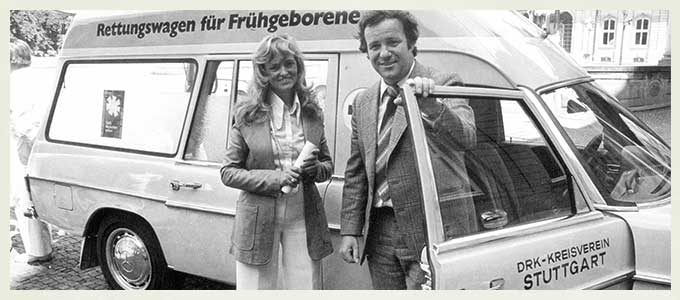
Even after the open letter to the interior ministers, no authority is prepared to initiate changes. The reason: emergency assistance does not officially fall within any area of responsibility. These responsibilities must first be created - which is why we set up the "North Württemberg Rescue Service Working Group" and other specialised committees under the chairmanship of Siegfried Steiger. The "State Rescue Service Committees" and the "Standing Conference on Rescue Services at the Federal Minister of Transport" later emerged from these committees.
vorheriger Meilenstein: 15 POINTS FOR EMERGENCY ASSISTANCE
nächster Meilenstein: COINS FOR EMERGENCIES

To make an emergency call via a telephone, you needed 20 pfennigs. We initiate symbolic campaigns with cardboard cards so that you don't run out of change in an emergency. These contain two 10 pfennig coins and are distributed and hung up in public telephones. After the Federal Post Office offered to set up a coin-free emergency call system at the beginning of the 1970s, we again put pressure on the interior ministers of the federal states.
It was not until 1984 that the coin-free emergency call system was introduced.
vorheriger Meilenstein: CREATING RESPONSIBILITIES
nächster Meilenstein: EMERGENCY PHONE

The Federal Ministry of Transport is installing 100 emergency telephones in various federal states on a trial basis. However, the latter are refusing to contribute to the costs. The federal government is therefore not pursuing the test any further. We find this unacceptable and are equipping a total of 35,000 kilometres of federal and state roads with emergency telephones ourselves.
Most emergency telephones had to have their own main telephone line, which was billed at DM 27.50 per month by the Bundespost.
vorheriger Meilenstein: COINS FOR EMERGENCIES
nächster Meilenstein: NOTARY 24/7

With the support of Motor-Presse-Stuttgart, we are financing a fully equipped emergency ambulance to be handed over to a German city. The requirement: an emergency doctor must be available around the clock. However, no major city wants to fulfil this requirement. It was only after the media coverage that the city of Stuttgart organised an emergency doctor service. This was the start of the 24-hour emergency doctor system in Germany.
Stuttgart's mayor Klett was initially unable to guarantee a crew: "Give me a new refuse collection vehicle, it will cost just as much!"
vorheriger Meilenstein: EMERGENCY PHONE
nächster Meilenstein: CAR EMERGENCY CALL
The motorways built after the war do not have an emergency call system - unlike the pre-war motorways. However, these are largely unused, which is why the Federal Ministry of Transport is considering dismantling them. In a conversation, Siegfried Steiger convinces Federal Transport Minister Georg Leber to retain the old systems and to equip them with modern emergency telephones. We also managed to get stationary emergency telephones installed on all new motorways from 1973.
The motorway alarm systems were only used for maintenance and were not intended for emergency calls.
vorheriger Meilenstein: NOTARY 24/7
nächster Meilenstein: THE BIRTH OF THE RESCUE SERVICE

In an emergency, rapid assistance is often vital for survival - and often has to be provided on the way to hospital. Until the end of 1971, injured and sick people were usually only transported by ambulance without medical equipment and without a paramedic to look after them. This only changed after we gave every federal state an ambulance with full medical equipment. This marked the birth of the ambulance service in Germany.
In many federal states, it was the first ambulance ever. The costs were partly covered by charity records.
vorheriger Meilenstein: CAR EMERGENCY CALL
nächster Meilenstein: STATE AIR RESCUE
You are currently viewing a placeholder content of Youtube. To access the actual content, click the button below. Please note that this involves passing data to third parties.
More informationThe German government is unable to finance the rescue helicopter promised for the greater Frankfurt area - and the ADAC also revises its funding commitment. We therefore buy the Christoph 2 rescue helicopter ourselves from the proceeds of a charity record and by mortgaging the Steiger family's home and hand it over to the Federal Ministry of the Interior. This overcomes one of the most difficult crises at the beginning of civil air rescue.
Initially, the Steiger star was not to be painted on the yellow helicopter due to allegedly strict weight specifications. Siegfried Steiger therefore had the helicopter weighed before the handover: it was 82 kilos too heavy. In order to obtain a licence anyway, he had the fuel tank reduced in size. As a result, other operators also had their Bo-105 machines weighed: They were all too heavy! As a result, Christoph 2 was initially the only aircraft of its kind with a licence to fly.
vorheriger Meilenstein: THE BIRTH OF THE RESCUE SERVICE
nächster Meilenstein: THE FOUNDATION OF THE DRF

It is not feasible for the German government to provide nationwide funding for air rescue. That is why we are ensuring the establishment and financing of the first civilian air rescue organisation in Germany: the German Air Rescue Service (DRF).
The helicopter is alerted during the opening of the first air rescue centre in Stuttgart: A serious car accident between Tübingen and Stuttgart.
vorheriger Meilenstein: STATE AIR RESCUE
nächster Meilenstein: RESCUE MODEL REMS-MURR

We are launching the self-financed "Rems-Murr rescue model". As part of this scientific structural analysis, a complete personnel and material calculation for an economically viable rescue service is carried out for the first time. On 25 March 1974, the model is adopted by the district council and later becomes the model for emergency assistance throughout Germany. The values calculated at that time are still valid today. As early as 1973, we demanded central control centres for several million inhabitants.
This project was the first in Europe to create a nationwide emergency response system with a central rescue control centre.
vorheriger Meilenstein: THE FOUNDATION OF THE DRF
nächster Meilenstein: EMERGENCY CALL 110/112
You are currently viewing a placeholder content of Youtube. To access the actual content, click the button below. Please note that this involves passing data to third parties.
More informationIn spring 1973, we introduce the emergency numbers 110/112 in all local networks of the German Federal Post Office in what was then the administrative district of North Württemberg. However, the nationwide introduction fails - Siegfried Steiger then sues the state of Baden-Württemberg and the Federal Republic of Germany before the Stuttgart Administrative Court for the introduction of the emergency number (case reference: II 139/73). As expected, the lawsuit is rejected on 3 September 1973, but leads to broad public support.
The emergency numbers 110 for the police and 112 for the fire and rescue services had been in use in Germany since 1956, but only a few large cities had switched them on.
vorheriger Meilenstein: RESCUE MODEL REMS-MURR
nächster Meilenstein: TELEMATIC EMERGENCY AMBULANCE

In the early 1970s, seriously injured trapped accident victims often have to wait a long time to be rescued because the fire brigade's heavy rescue vehicles arrive at the scene of the accident too late or not at all. In order to be able to rescue trapped accident victims more quickly, we develop an all-terrain rapid rescue vehicle (SBW) together with the Stuttgart fire brigade. We are financing more than ten of these vehicles.
Today, the successors are in use worldwide under the name "Vorrüstwagen" (VRW).
vorheriger Meilenstein: PRIORITY FOR EMERGENCY VEHICLES
nächster Meilenstein: BABY AMBULANCE
Following the systematic introduction of the emergency doctor system, problems arise at the interface between the ambulance service and the emergency department. Although patients arrive at the hospital quickly, the patient data must first be recorded there, which is time-consuming. As a result, treatment is often delayed. In order not to lose any time, we are developing the first European telematics emergency ambulance, from which patient data can be transmitted directly to the hospital by radio. Unfortunately, the successful trial had to be cancelled after six months because the German Federal Post Office only made the necessary radio frequencies available for six months.
vorheriger Meilenstein: EMERGENCY CALL 110/112
nächster Meilenstein: FIRST ALL-GERMAN AIR RESCUE MISSION

Until 1974, Germany had the highest infant mortality rate of all industrialised nations. The reason: the separation of maternity and paediatric clinics still practised in Germany. Problematic transports without medical care often lead to late effects or even death. This is why we are developing and financing the first baby emergency ambulance with an integrated transport incubator. Infant mortality in maternity clinics falls by almost 70 per cent in the first year. We have financed a total of 14 baby emergency ambulances.
Premature babies under 1,000 grams were still "disposed of" back then. Today, children born with less than 500 grams have a chance of a healthy life.
vorheriger Meilenstein: FAST MOUNTING
nächster Meilenstein: PARAMEDIC

As early as 1969, Siegfried Steiger called for a job description for paramedics in his 15-point programme. Now we are providing a further important impetus for this and are financing the training of a paramedic of the German Red Cross for two years with DM 50,000. More and more experts are joining in.
It was not until 1 September 1989 that the job description of "paramedic" was regulated by law.
vorheriger Meilenstein: BABY AMBULANCE
nächster Meilenstein: ORGAN TRANSPORT
In July 1976, 32 West Berliners are seriously injured in a bus accident in Afghanistan. To avoid political problems on the flight to Berlin, Siegfried Steiger charters an Interflug wide-bodied aircraft from the GDR Minister of Transport. The aircraft takes off from Stuttgart with 30 doctors and paramedics on board and flies the injured from Kabul to East Berlin. There they are taken by 32 West Berlin ambulances through the sector border to West Berlin clinics.
vorheriger Meilenstein: TELEMATIC EMERGENCY AMBULANCE
nächster Meilenstein: THE FIRST INITIATIVE AGAINST SUDDEN CARDIAC DEATH
After a cardiac arrest, resuscitation measures must be started immediately, otherwise the chances of survival drop rapidly. The first early defibrillation devices come onto the market in 1976. On 22 April 1977, we buy the first device and hand it over to the non-medical rescue service in Ludwigsburg. The initiative fails due to resistance from the medical profession and authorities, who insist that life-saving early defibrillation may only be carried out by doctors. It was not until May 2001 that the German Medical Association recommended defibrillation by laypersons using automated external defibrillators.
vorheriger Meilenstein: FIRST ALL-GERMAN AIR RESCUE MISSION
nächster Meilenstein: DEVELOPMENT AND FINANCING OF EMERGENCY MEDICAL SERVICE VEHICLES (NEF)

Ideally, the emergency doctor, paramedic and ambulance driver should be based at the same ambulance station. Where this is not possible, emergency doctors are collected from the hospital after being alerted. This leads to considerable time delays. That is why we are developing an emergency ambulance that emergency doctors can drive to the scene of an emergency independently. The vehicle is presented to the public for the first time in 1979 at the International Motor Show in Frankfurt am Main. In order to accelerate the spread of the NEF, we donate one NEF each to the four aid organisations Arbeiter-Samariter-Bund, Deutsches Rotes Kreuz, Johanniter-Unfall-Hilfe and Malteser Hilfsdienst in Bonn in 1980.
Today, NEFs are an integral part of the rescue service.
vorheriger Meilenstein: THE FIRST INITIATIVE AGAINST SUDDEN CARDIAC DEATH
nächster Meilenstein: FIRST EMERGENCY TELEPHONE WITH SOLAR POWER SUPPLY
On 28 August 1980, a solar-powered emergency telephone is put into operation on the Bundesstraße 14 - the first large-scale test for solar power supply in the low-voltage range. This was preceded by years of laboratory tests. We thus made an important contribution to the development of low-voltage solar systems. Unfortunately, the trial could not be continued because the costs were too high. It was not until the year 2000 that the costs of a solar system fell to such an extent that some of the emergency telephones could be supplied with solar systems from then on.
vorheriger Meilenstein: DEVELOPMENT AND FINANCING OF EMERGENCY MEDICAL SERVICE VEHICLES (NEF)
nächster Meilenstein: PRIORITY FOR EMERGENCY VEHICLES